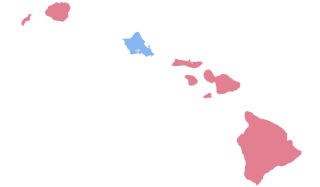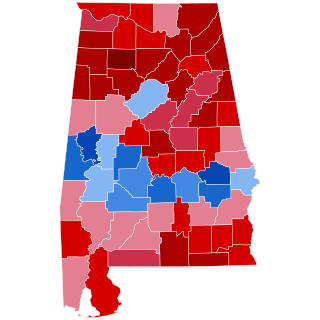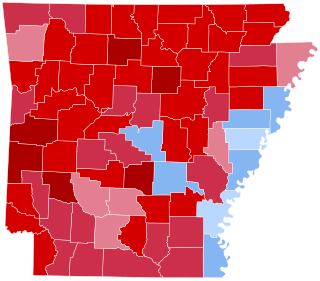
In the United States, a certificate of ascertainment is an official document that identifies a state's appointed electors for U.S. President and Vice President, and the final vote count for each candidate that received popular votes. [1]

In the United States, a certificate of ascertainment is an official document that identifies a state's appointed electors for U.S. President and Vice President, and the final vote count for each candidate that received popular votes. [1]
After a presidential election, [2] [3] the ascertainment is submitted by the governor of each state (and by the mayor of the District of Columbia) to the Archivist of the United States [4] [5] [6] and others, [7] in accordance with 3 U.S.C. §§ 6–14 [8] [9] and the Electoral Count Act. [10] [11] Within the United States' electoral system, the certificates "[represent] a crucial link between the popular vote and votes cast by electors". [12]
The certificates must bear the state seal and the governor's signature. Each state is free to choose the appearance and layout of the certificate. Staff from the Office of the Federal Register ensure that each certificate contains all legally required information. [13] States are required to produce either seven original certificates with two certified copies, or nine original certificates; of these, one original and either two more originals or two copies, are sent to the Archivist via registered mail or a commercial carrier. Both the House and the Senate receive one of the copies. [13]
When each state's electors meet to vote (on the first Monday after the second Wednesday of December), [3] they sign and record their vote on six "certificates of the vote", [9] [11] which are then paired with the six remaining certificates of ascertainment. One pair of certificates is sent to the president of the Senate; two pairs are sent to the Archivist; two pairs are sent via registered mail to the state's secretary of state; and one pair is sent to the chief judge of the closest United States district court. [14] [15] One of each of the two pairs sent to the Archivist and the secretary of state are designated for public inspection, while the others (and the chief judge's copy) are "held subject to the order of the President of the United States Senate". [13] The Archivist must receive the certificates by the fourth Wednesday in December, [11] and may take "extraordinary measures to retrieve duplicate originals" otherwise. [13]
The Vice President, as President of the Senate, opens the certificates in alphabetical order by state during a joint session of Congress in the House chamber on January 6 and gives them to one of four "tellers", two from the House and two from the Senate, who, seated at the clerks' desks, tally the vote. [15] [16]

In the United States, the Electoral College is the group of presidential electors that is formed every four years for the sole purpose of voting for the president and vice president. The process is described in Article II of the U.S. Constitution. Each state appoints electors under the methods described by its legislature, equal in number to its congressional delegation totaling 535 electors. A 1961 amendment granted the federal District of Columbia three electors. Of the current 538 electors, a simple majority of 270 or more electoral votes is required to elect the president and vice president. If no candidate achieves a majority there, a contingent election is held by the House of Representatives to elect the president and by the Senate to elect the vice president. Federal office holders, including senators and representatives, cannot be electors.

The Electoral Commission, sometimes referred to as the Hayes-Tilden or Tilden-Hayes Electoral Commission, was a temporary body created by the United States Congress on January 29, 1877, to resolve the disputed United States presidential election of 1876. Democrat Samuel J. Tilden and Republican Rutherford B. Hayes were the main contenders in the election. Tilden won 184 undisputed electoral votes, one vote shy of the 185 needed to win, to Hayes' 165, with 20 electoral votes from four states unresolved. Both Tilden and Hayes electors submitted votes from these states, and each claimed victory.
Title 3 of the United States Code outlines the role of the President of the United States in the United States Code.
The president-elect of the United States is the candidate who has presumptively won the United States presidential election and is awaiting inauguration to become the president. There is no explicit indication in the U.S. Constitution as to when that person actually becomes president-elect, although the Twentieth Amendment uses the term "president-elect", thus giving the term "president-elect" constitutional justification. It is assumed the Congressional certification of votes cast by the Electoral College of the United States – occurring after the third day of January following the swearing-in of the new Congress, per provisions of the Twelfth Amendment – unambiguously confirms the successful candidate as the official "president-elect" under the U.S. Constitution. As an unofficial term, president-elect has been used by the media since at least the latter half of the 19th century, and was in use by politicians since at least the 1790s. Politicians and the media have applied the term to the projected winner, even on election night, and very few who turned out to have lost have been referred to as such.

The 2008 United States presidential election in the District of Columbia took place on November 4, 2008, and was part of the 2008 United States presidential election. In D.C., voters chose three representatives, or electors to the Electoral College, who voted for president and vice president. Prior to the election, the nation's capital was considered to be a certain lock for Obama. Washington D.C. is fiercely Democratic and has voted for the Democratic candidate in every presidential election by large margins since 1964 when the District gained the right to electoral representation through the 23rd amendment.

The election of the president and the vice president of the United States is an indirect election in which citizens of the United States who are registered to vote in one of the fifty U.S. states or in Washington, D.C., cast ballots not directly for those offices, but instead for members of the Electoral College. These electors then cast direct votes, known as electoral votes, for president, and for vice president. The candidate who receives an absolute majority of electoral votes is then elected to that office. If no candidate receives an absolute majority of the votes for president, the House of Representatives elects the president; likewise if no one receives an absolute majority of the votes for vice president, then the Senate elects the vice president.

The 1960 presidential election in Hawaii was held on November 8, 1960, as part of the 1960 United States presidential election. This was the first presidential election in which Hawaii participated; the state had been admitted to the Union just over a year earlier. The islands favored Senator John F. Kennedy, a Democrat, by a narrow margin of 115 votes, or 0.06%, after a court-ordered recount overturned an initial result favoring Vice President Richard Nixon, a Republican. The result was considered an upset, as Nixon had been thought likely to win the state's electoral votes.

In the 2016 United States presidential election, ten members of the Electoral College voted or attempted to vote for a candidate different from the ones to whom they were pledged. Three of these votes were invalidated under the faithless elector laws of their respective states, and the elector either subsequently voted for the pledged candidate or was replaced by someone who did. Although there had been a combined total of 155 instances of individual electors voting faithlessly prior to 2016 in over two centuries of previous US presidential elections, 2016 was the first election in over a hundred years in which multiple electors worked to alter the result of the election.

The 2020 United States presidential election in Alabama took place on Tuesday, November 3, 2020, as part of the 2020 United States presidential election in which all 50 states and the District of Columbia participated. Alabama voters chose nine electors to represent them in the Electoral College via a popular vote pitting incumbent Republican President Donald Trump and his running mate, incumbent Vice President Mike Pence, against Democratic challenger and former Vice President Joe Biden and his running mate, United States Senator Kamala Harris of California. Also on the ballot was the Libertarian nominee, psychology lecturer Jo Jorgensen and her running mate, entrepreneur and podcaster Spike Cohen. Write-in candidates were permitted without registration, and their results were not individually counted.

The 2020 United States presidential election in Alaska took place on Tuesday, November 3, 2020, as part of the 2020 United States presidential election in which all 50 states and the District of Columbia participated. Alaska voters chose three electors to represent them in the Electoral College via a popular vote pitting incumbent Republican President Donald Trump and his running mate, incumbent Vice President Mike Pence, against Democratic challenger and former Vice President Joe Biden and his running mate, United States Senator Kamala Harris of California. The Libertarian, Green, Constitution, and Alliance Party nominees were also on the ballot, as was an Independent candidate.

The 2020 United States presidential election in Arkansas took place on Tuesday, November 3, 2020, as part of the 2020 United States presidential election in which all 50 states plus the District of Columbia participated. Arkansas voters chose six electors to represent them in the Electoral College via a popular vote pitting incumbent Republican President Donald Trump and his running mate, incumbent Vice President Mike Pence, against Democratic challenger and former Vice President Joe Biden and his running mate, United States Senator Kamala Harris of California. Also on the ballot were the nominees for the Libertarian, Green, Constitution, American Solidarity, Life and Liberty, and Socialism and Liberation parties and Independent candidates. Write-in candidates are not allowed to participate in presidential elections.

The 2020 United States presidential election in Pennsylvania was held on Tuesday, November 3, 2020, as part of the 2020 United States presidential election in which all 50 states plus the District of Columbia participated. Pennsylvania voters chose electors to represent them in the Electoral College via a popular vote, pitting the Republican Party's nominee, President Donald Trump, and running mate Vice President Mike Pence against Democratic Party nominee, former Vice President Joe Biden, and his running mate California Senator Kamala Harris. Pennsylvania has 20 electoral votes in the Electoral College.

The Electoral Count Act of 1887 (ECA) is a United States federal law that added to procedures set out in the Constitution of the United States for the counting of electoral votes following a presidential election. In its unamended form, it last governed at the time of the 2021 United States Electoral College vote count. The Act has since been substantially amended by the Electoral Count Reform and Presidential Transition Improvement Act of 2022.
The following is a timeline of major events before, during, and after the 2020 United States presidential election, the 59th quadrennial United States presidential election, from November 2020 to January 2021. For prior events, see Timeline of the 2020 United States presidential election (2017–2019) and Timeline of the 2020 United States presidential election.

The count of the Electoral College ballots during a joint session of the 117th United States Congress, pursuant to the Electoral Count Act, on January 6–7, 2021, was the final step to confirm President-elect Joe Biden's victory in the 2020 presidential election over President Donald Trump.

The Eastman memos, also known as the "coup memo", are documents by John Eastman, an American law professor retained by then-President Donald Trump advancing the fringe legal theory that a U.S. Vice President has unilateral authority to reject certified State electors. This would have the effect of nullifying an election in order to produce an outcome personally desired by the Vice President, such as a result in the Vice President's own party's favor, including retaining himself as Vice President, or if the Vice President is himself the presidential candidate, then to unilaterally make himself president.

The count of the Electoral College ballots during a joint session of the 115th United States Congress, pursuant to the Electoral Count Act, on January 6, 2017, was the final step to confirm then-President-elect Donald Trump's victory in the 2016 presidential election over Hillary Clinton.
Following the results of the 2020 United States presidential election, an obstruction scheme was devised by outgoing 45th U.S. president Donald Trump and his allies in seven states, Pennsylvania, Georgia, Michigan, Arizona, Wisconsin, Nevada, and New Mexico, to create and submit fraudulent certificates of ascertainment that falsely asserted Trump had won the electoral college vote in those states. The intent of the scheme was to pass the fraudulent certificates to then-vice president Mike Pence in the hope he would count them, rather than the authentic certificates, and thus overturn Joe Biden's victory. This effort helped form a fringe legal theory outlined by Trump attorney John Eastman in the Eastman memos, which claimed the vice president has constitutional discretion to swap official electors with an alternate slate during the certification process, thus changing the outcome of the electoral college vote and the overall winner of the presidential race. The scheme came to be known as the Pence Card. By 2023, many individuals in several states had been indicted for their alleged involvement, with other investigations underway.

The Electoral Count Reform and Presidential Transition Improvement Act of 2022 is a revision of the Electoral Count Act of 1887, adding to procedures set out in the Constitution of the United States for the counting of electoral votes following a presidential election. It also amended the Presidential Transition Act.